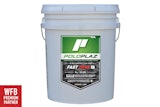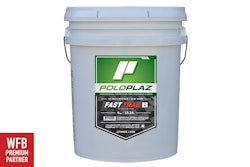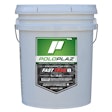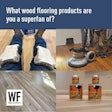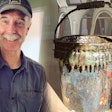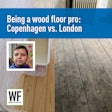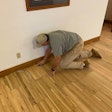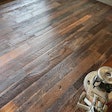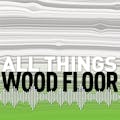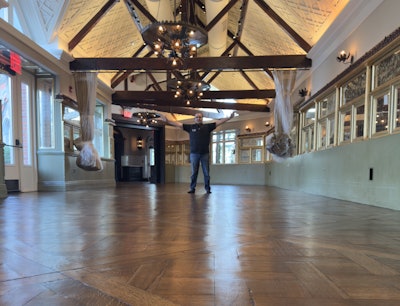
Every single time we do a job, we approach it as a challenge. Sometimes the challenge is very simple, and sometimes it can get very complicated. This job at the historic Tavern on the Green restaurant in New York City definitely was in the “very complicated” category.
The Tavern on the Green, one of the most famous restaurants in the world, closed in 2009 but reopened in 2014. We had installed the wood flooring in the restaurant, and it took months just to gather enough material, because we needed rift and quartered white oak reclaimed from barns. We had created a very large parquet pattern that was hand-scraped and designed to look like it had been in place for 100 years, with visible wear patterns, even though it was a brand new floor. We created the effect with oxidative products and wax; one room had a light fumed color, and the other was a rich dark brown.


When the job was complete, we tried to sell the maintenance contract, but they chose a lower-cost option. It was horrible for us to think about what was happening to that floor with hundreds of people on it every day and not being able to do the correct maintenance, but there was nothing we could do. Fast forward 11 years, and my business partner, Vartan Arutyunian, and I were on a job at an apartment building in the city. I mentioned to Vartan that the color we were creating looked like the brown from the Tavern on the Green. The homeowner said, “Did you say Tavern on the Green? The owner lives here!” The next morning when we got to the job, David, the owner we had worked with more than a decade ago was there, asking us to please come back and help his wood floors look like they had when we first created them.
When we saw the floors, it looked like someone had just applied new coats of wax to the dirty floor, with no new color, every week. There were real wear patterns now, and the color in the wear patterns was totally gone. Our challenge now was: How can I add color back into this floor while maintaining the hand-scrape we created when the floor was new and also maintain the appearance of the wear patterns? If we sanded the floor flat, it would lose its beautiful texture. But we needed to figure out how to get the floor with so many layers of wax to accept color.
When we did the floor originally, we didn’t have the LED-cured oil finishes we do now. I knew that our current LED-cured finishes were compatible with wax—they have some wax in them. But how could we get the color into the existing floor? I went back to our chemists at the lab in Germany and explained our situation. I asked: What’s the ingredient inside the finish that makes the wax melt? Could we use more of that on this floor to open up the wax on this floor so we could recreate the beautiful original colors?

They explained what we needed to do, but before we tried it at the restaurant, we created a quartersawn white oak panel at our shop where we used a 2,000 rpm buffer to burnish in layers of wax over and over to replicate as much as possible what the actual Tavern on the Green floors were like. We tried our process, and it worked.

The next step was to try sample areas behind the couches at the actual Tavern on the Green. When those worked, we did the entire floor—and the process worked so well, the color was darker than we planned. I had been so scared that we wouldn’t be able to get the color into this floor, and now I had too much color! David said it was acceptable, although it was darker than he would like. I told him, “Don’t call me for a few months. Let it start wearing off, and then we will start maintenance with another thin coat of oil.” He called me last week and said, “I think we are ready—it’s beautiful with the traffic pattern now.”

Honestly, it was emotional being able to return to this historic job and restore the floors to their original beauty. I would encourage all wood flooring pros to think about this: Every time you create something, how are you going to maintain it for the rest of your life? Can you recreate the color if you need to? Can you rejuvenate everything after 10 years? You need to use products and processes that enable you to do that so create a genuine lifetime wood floor.










